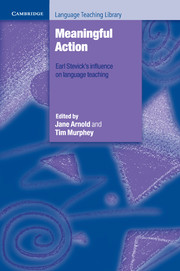Book contents
- Frontmatter
- Contents
- List of contributors
- Acknowledgements
- Preface
- Introduction
- Part A Meaning-making inside and between the people in the classroom
- Part B Meaningful classroom activity
- Part C Frameworks for meaningful language learning
- Epilogue: A way with words – perspectives on the contributions and influence of Earl W. Stevick
- Appendix: Words of tribute to Earl Stevick
- Index
Part A - Meaning-making inside and between the people in the classroom
Published online by Cambridge University Press: 15 November 2023
- Frontmatter
- Contents
- List of contributors
- Acknowledgements
- Preface
- Introduction
- Part A Meaning-making inside and between the people in the classroom
- Part B Meaningful classroom activity
- Part C Frameworks for meaningful language learning
- Epilogue: A way with words – perspectives on the contributions and influence of Earl W. Stevick
- Appendix: Words of tribute to Earl Stevick
- Index
Summary
Earl Stevick (1980: 4) made an important point when he affirmed that success in language learning depends to a large extent on what goes on ‘inside and between the people in the classroom’. This implies that taking into account the ‘inside’, the intrapersonal aspects of learners, can help us as teachers to make learning more meaningful and thus more effective, while the second aspect, the ‘between’, reminds us that often meaning is not made alone. Stevick stated that he came to understand that the most important part of what ‘goes on’ is ‘the presence or absence of harmony – it is the parts working with, or against, one another’ (1980: 5). Harmony may refer to whole-person learning where the body, mind and emotions of the learner work together, but it also includes in a very central way the need to establish a good atmosphere and productive relationships ‘between the people’ in the classroom. Stevick (1980: 22) refers to Becker's notion that as human beings we don't establish and maintain our own meaning by ourselves; we make meaning together.
The importance of the other in learning is essential. Vygotsky stressed that the intermental (between minds) comes before the intramental (within the individual): ‘Any function in the child's cultural development appears twice, or on two planes; first it appears on the social plane, and then on the psychological plane, first it appears between people as an interpsychological category, and then within the child as an intrapsychological category’ (Vygotsky 1981: 163). This process of internalization is usually the result of meaningful action, both socially and personally.
In language learning, opening a coursebook and doing a grammar exercise could be considered action. In language teaching, presenting the class with a detailed explanation of verb tenses could also be considered action. However, in both cases they would not necessarily be experienced as meaningful action. From his research Littlejohn (2008: 214) finds that many learners ‘appear to see their classes as mainly consisting of “exercises”, free of any memorable content’. Even in a class based on communicative language teaching, activities may not seem relevant to learners.
- Type
- Chapter
- Information
- Meaningful ActionEarl Stevick's Influence on Language Teaching, pp. 7 - 10Publisher: Cambridge University PressPrint publication year: 2013



